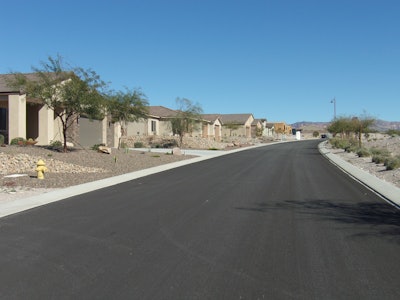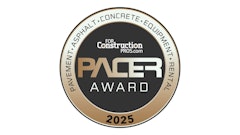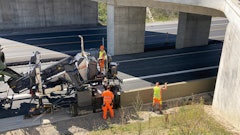
Nestled within the foothills of Bullhead City, AZ, which is located on the Colorado River, the Laughlin Ranch Community and Golf Course was the focus of a maintenance project by American Pavement Preservation, headquartered in Las Vegas.
Located 105 miles south of Las Vegas, the area sports spectacular views and an interesting and demanding layout, giving the Laughlin community a standout golf course to call its own. This upscale golf course community is still in the process of building homes and developing itself, but offers many amenities for the residents.
The asphalt pavement conditions were in a fair condition within the gated residential community with approximately 70% of the streets having surface raveling and some block cracking, says Eric Reimschiissel, owner of American Pavement Preservation. The remaining roads were in moderate condition. Reimschiissel decided Type 1 slurry seal was a good application for preserving these streets.
Preparation involves communication
Pre-production sampling of emulsion and aggregate was done, and underwent testing at a certified laboratory for mix design analysis of the slurry seal material. The crack seal sealant was also tested for verification of mix properties as well. A pre-drive of all the street sections was completed and schedule maps drawn up for the work.
This project required good communication and cooperation with the management of the community.
“Communication between the client and homeowners was vital in making things go smoothly,” says Reimschiissel. “A lot of residents required daily access in and out of the neighborhood, as well as golf course participants in golf carts crossing between fairways.”
The residents were given two notifications of the upcoming work, a five-day notice explaining the nature of the work that was about to commence within the neighborhood and a 24-hour notice validating the road work for the next day.
“The 24-hour notice explains more in-depth of the activities that would be going on within their street,” explains Reimschiissel. “With each phase of work, we made sure the residents were given notification.”
Steps to success
American Pavement Preservation started slurry seal operations with the application of hot-applied crack seal sealant on pavement surface cracks a ¼ “+ in width on all the street sections. The five-person crack seal crew used Crafco machines.
"The crack seal material used for this project was a modified design for hot climate," says Reimschiissel. "In this area, summer temperatures can rise as high as 120 degrees F and pavement surface temperatures to 180 degrees F."
Next on the schedule was the application of Type 1 Slurry Seal surface treatment to the street sections. This material consisted of a 3% latex modified (LM-CQS) Type 1 aggregate formulated for hot weather placement. The average application rate by the 10-person crew was 10 lbs. per square yard using Macropaver slurry machines.
The project was wrapped up with the installation of traffic striping, including stop bars, crosswalks, legends, etc.
“The entire project took approximately five weeks covering 165,000 square yards,” says Reimschiissel. “It turned out to be quite a success. We had very satisfied clients in a beautiful community, and we were able to increase the condition and longevity of their streets.
“We need to thank the management for their cooperation and professionalism during the project,” he concludes. “Their contribution to the project was vital and appreciated.”






![[Video] Bettis Asphalt Relies on Cat F-Series Paver on Wanamaker Road Project](https://img.forconstructionpros.com/files/base/acbm/fcp/image/2016/12/default.58507c7b77bb2.png?auto=format%2Ccompress&fit=crop&h=167&q=70&w=250)












